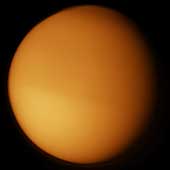
Saturn VI
|
Titan Table of Contents |
|
Titan
|
|
Saturn Contents |
|
Saturn's Moons |
|
Atlas,
Calypso,
Dione,
Enceladus,
Epimetheus,
Helene,
Hyperion,
Iapetus,
Janus,
Mimas,
Pan,
Pandora,
Phoebe,
Prometheus,
Rhea,
Telesto,
Tethys,
Titan,
Possible New Satellites |
|
Saturn Science |
Although Titan is classified as a moon, it is larger than the planets Mercury and Pluto. It has a planet-like atmosphere which is more dense than those of Mercury, Earth, Mars and Pluto. The atmospheric pressure near the surface is about 1.6 bars, 60 percent greater than Earth's. Titan's air is predominantly made up of nitrogen with other hydrocarbon elements which give Titan its orange hue. These hydrocarbon rich elements are the building blocks for amino acids necessary for the formation of life. Scientists believe that Titan's environment may be similar to that of the Earth's before life began putting oxygen into the atmosphere.
Titan's surface temperature appears to be about -178°C (-289°F). Methane appears to be below its saturation pressure near Titan's surface; rivers and lakes of methane probably don't exist, in spite of the tantalizing analogy to water on Earth. On the other hand, scientists believe lakes of ethane exist that contain dissolved methane. Titan's methane, through continuing photochemistry, is converted to ethane, acetylene, ethylene, and (when combined with nitrogen) hydrogen cyanide. The last is an especially important molecule; it is a building block of amino acids.
The Voyager spacecrafts were not able to penetrate the thick layers of clouds but they did reveal that Titan is one of the more interesting places in the solar system. What kind of landscape lies below the layers of clouds? What mysteries are held beneath these orange curtains? These questions will have to wait until future spacecraft are launched to visit this unusual moon. On October 15, 1997, the Cassini spacecraft was launched for a rendezvous with Saturn in June 2004. Later that year, it will release the European-built Huygens probe for a descent through Titan's atmosphere. Cassini will have more than 30 encounters with Titan, mapping the moon's surface with a synthetic aperature radar similar to the one Magellan used to map Venus.
| Titan Statistics | |
|---|---|
| Discovered by | Christiaan Huygens |
| Date of discovery | 1655 |
| Mass (kg) | 1.35e+23 |
| Mass (Earth = 1) | 2.2590e-02 |
| Equatorial radius (km) | 2,575 |
| Equatorial radius (Earth = 1) | 4.0373e-01 |
| Mean density (gm/cm^3) | 1.88 |
| Mean distance from Saturn (km) | 1,221,850 |
| Rotational period (days) | 15.94542 |
| Orbital period (days) | 15.94542 |
| Mean orbital velocity (km/sec) | 5.58 |
| Orbital eccentricity | 0.0292 |
| Orbital inclination (degrees) | 0.33 |
| Escape velocity (km/sec) | 2.65 |
| Visual geometric albedo | 0.21 |
| Magnitude (Vo) | 8.28 |
| Mean surface temperature | -178°C |
| Atmospheric pressure (bars) | 1.5 |
 Titan
Titan
Opaque layers of clouds prevented
Voyager from seeing Titan's surface
during its 1980 flyby. The clouds over the southern hemisphere are
lighter in color than over the northern hemisphere.
There is a dark hood over the north pole.
(Copyright Calvin J. Hamilton)
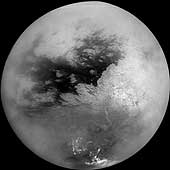 Hovering Over Titan
Hovering Over Titan
A mosaic of nine processed images recently acquired during Cassini's first
very close flyby of Saturn's moon Titan on Oct. 26, 2004, constitutes the
most detailed full-disc view of the mysterious moon.
The view is centered on 15 degrees South latitude, and 156 degrees West longitude. Brightness variations across the surface and bright clouds near the south pole are easily seen.
The images that comprise the mosaic have been processed to reduce the effects of the atmosphere and to sharpen surface features. The mosaic has been trimmed to show only the illuminated surface and not the atmosphere above the edge of the moon. The Sun was behind Cassini so nearly the full disc is illuminated. Pixels scales of the composite images vary from 2 to 4 kilometers per pixel (1.2 to 2.5 miles per pixel).
Surface features are best seen near the center of the disc, where the spacecraft is looking directly downwards; the contrast becomes progressively lower and surface features become fuzzier towards the outside, where the spacecraft is peering through haze, a circumstance that washes out surface features.
The brighter region on the right side and equatorial region is named
Xanadu Regio. Scientists are actively debating what processes may have
created the bizarre surface brightness patterns seen here. The images
hint at a young surface with, no obvious craters. However, the exact
nature of that activity, whether tectonic, wind-blown, fluvial, marine,
or volcanic is still to be determined.
(Courtesy NASA/JPL/Space Science Institute)
 Titan: Complex 'Anti-greenhouse'
Titan: Complex 'Anti-greenhouse'
This natural color image shows Titan's upper atmosphere -- an active place
where methane molecules are being broken apart by solar ultraviolet light
and the byproducts combine to form compounds like ethane and acetylene.
The haze preferentially scatters blue and ultraviolet wavelengths of
light, making its complex layered structure more easily visible at the
shorter wavelengths used in this image.
Lower down in the atmosphere, the haze turns into a globe-enshrouding smog
of complex organic molecules. This thick, orange-colored haze absorbs
visible sunlight, allowing only perhaps 10 percent of the light to reach
the surface. The thick haze is also inefficient at holding in and then
re-radiating infrared (thermal) energy back down to the surface. Thus,
despite the fact that Titan has a thicker atmosphere than Earth, the
thick global haze causes the greenhouse effect there to be somewhat weaker
than it is on Earth.
(Courtesy NASA/JPL/Space Science Institute)
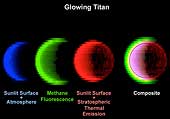 Glowing Titan
Glowing Titan
The glow of Titan's extensive atmosphere shines in false colors in this
view of Saturn's gas-enshrouded moon acquired by the Cassini spacecraft
visual and infrared mapping spectrometer during the July 2, 2004, flyby.
While flying over the terminator, where Titan's day and night meet, both the dayside and night sides are seen at various wavelengths. In these views of the crescent moon, the sunlit side is on the left and the nightside on the right. The blue image shows the sunlit crescent as observed at a wavelength that pierces through the thick atmosphere to show only the surface. This image is much smaller than the other three images to the right, because it does not show any atmospheric affects.
In contrast, the green image shows the immense size of Titan's atmosphere. This is revealed by the fluorescent glow of methane gas, which extends over 700 kilometers (435 miles) above the surface, showing that the atmosphere nearly doubles the size of Titan. This glow is at a wavelength of 3.3 microns, five times the wavelength visible to the human eye.
The red image shows that Titan also glows at night, which initially surprised scientists. The moon glows out to more than 200 kilometers (124 miles) in altitude, indicating carbon-monoxide emission at the 4.7 micron wavelength produced in Titan's relatively warm stratosphere.
The multicolor image on the far right combines the three previous images
into one composite. Here it is seen that the carbon monoxide glow extends
over the dayside as well, producing the yellow layer observed on the left. This is because the two glows, one from methane (green) and carbon monoxide (red) mix together to form yellow in this multi-color composite. Titan's surface is indicated by the circle. Titan's surface appears purple due to the mixing of the blue and red surface images.
(Courtesy NASA/JPL/University of Arizona)
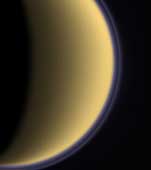 Purple Haze
Purple Haze
Encircled in purple stratospheric haze, Titan appears as a softly glowing sphere in this colorized image taken one day after Cassini's first flyby of that moon.
This image shows two thin haze layers. The outer haze layer is detached and appears to float high in the atmosphere. Because of its thinness, the high haze layer is best seen at the moon's limb.
The image was taken using a spectral filter sensitive to wavelengths of ultraviolet light centered at 338 nanometers. The image has been falsely colored: The globe of Titan retains the pale orange hue our eyes usually see, and both the main atmospheric haze and the thin detached layer have been brightened and given a purple color to enhance their visibility.
The best possible observations of the detached layer are made in ultraviolet light because the small haze particles which populate this part of Titan's upper atmosphere scatter short wavelengths more efficiently than longer visible or infrared wavelengths.
Images like this one reveal some of the key steps in the formation and evolution of Titan's haze. The process is thought to begin in the high atmosphere, at altitudes above 400 kilometers (250 miles), where ultraviolet light breaks down methane and nitrogen molecules. The products are believed to react to form more complex organic molecules containing carbon, hydrogen and nitrogen that can combine to form the very small particles seen as haze. The bottom of the detached haze layer is a few hundred kilometers above the surface and is about 120 kilometers (75 miles) thick.
The image was taken with the narrow angle camera on July 3, 2004, from a
distance of about 789,000 kilometers (491,000 miles) from Titan and at a
Sun-Titan-spacecraft, or phase, angle of 114 degrees. The image scale is
4.7 kilometers (2.9 miles) per pixel.
(Courtesy NASA/JPL/Space Science Institute)
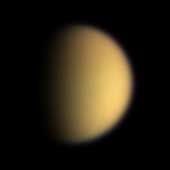 Titan in Natural Color
Titan in Natural Color
Despite the views of the surface of Saturn's Titan moon provided by the
Cassini spacecraft, the moon remains inscrutable to the human eye. Images
taken with the narrow angle camera using red, green and blue color filters
were combined to create this view.
In true-color images taken in visible wavelengths, Titan's photochemical smog, rich in organic material, gives the moon a smooth, featureless, orange glow.
The Cassini orbiter carries specially designed spectral filters that can pierce Titan's veil. Furthermore, its piggybacked Huygens probe will descend through the atmosphere in early 2005, giving an up-close-and-personal look at this mysterious orange moon.
The images making up this color view were obtained at a
Sun-Titan-spacecraft, or phase, angle of 67 degrees, and from a distance
of approximately 13.1 million kilometers (8.2 million miles) on June 10,
2004. The image scale is approximately 79 kilometers (49 miles) per pixel.
(Courtesy NASA/JPL/Space Science Institute)
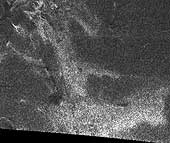 Oozing Across Titan
Oozing Across Titan
This synthetic aperture radar image of the surface of Saturn's moon Titan
was acquired on Oct. 26, 2004, when the Cassini spacecraft flew
approximately 2,500 kilometers (1,553 miles) above the surface and
acquired radar data for the first time.
The radar illumination was from the south: dark regions may represent areas that are smooth, made of radar-absorbing materials, or are sloped away from the direction of illumination. A striking bright feature stretches from upper left to lower right across this image, with connected 'arms' to the East. The fact that the lower (southern) edges of the features are brighter is consistent with the structure being raised above the relatively featureless darker background. Comparisons with other features and data from other instruments will help to determine whether this is a cryovolcanic flow, where water-rich liquid has welled up from Titan's warm interior.
The image covers an area about 150 kilometers (90 miles) square, and is
centered at about 45 degrees north, 30 degrees west in the northern
hemisphere of Titan, over a region that has not yet been imaged optically. The smallest details seen on the image are around 1 kilometer (.62 mile) across. Features are less clear at the bottom of the image where the viewing was less favorable. A faint horizontal seam between the radar beams can be seen half way up in this image.
(Courtesy NASA/JPL)
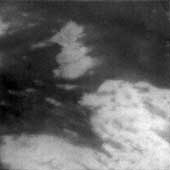 Surface Streaks
Surface Streaks
This medium-resolution view shows some of the surface streaks of Titan's
equatorial terrain. The streaks are oriented roughly east to west;
however, some streaks curve to the north and others curve to the south,
perhaps due to the topography of this region. North is a few degrees to
the right of vertical. The scale is .85 kilometers (.53 miles) per pixel.
This image was taken on Oct. 26, 2004, by Cassini's imaging science
subsystem using near-infrared filters.
(Courtesy NASA/JPL/Space Science Institute)
 Radar Shows Titan Live and in Color
Radar Shows Titan Live and in Color
Saturn's moon Titan shows a sharp contrast between its smooth and rough
edges in a new false-color radar image.
To provide a better perspective of the surface features, the color image is shown alongside a black and white image that was previously released. To read the full caption for the black and white image click here PIA06988.
In the new color image, brighter areas may correspond to rougher terrains, slopes facing the radar, or different materials. The pink colors enhance smaller details on the surface, while the green color represents smoother areas. Winding linear features that cut across dark areas may be ridges or channels, although their nature is not yet understood. A large dark circular feature is seen at the western (top left) end of the image, but very few features on Titan resembling fresh impact craters are seen.
The area shown is in the northern hemisphere of Titan and is about 150
kilometers (93 miles) wide by 300 kilometers (186 miles) long. The image
is a part of a larger strip created from data taken on Oct. 26, 2004,
when the Cassini spacecraft flew approximately 1,200 kilometers (745
miles) above Titan's surface.
(Courtesy NASA/JPL)
 Titan Close-up
Titan Close-up
Shown here is a blowup of a region of Titan imaged on July 2, 2004. This
image was taken at a distance of 339,000 kilometers (210,600 miles) and
shows brightness variations on the surface of Titan and a bright field of
clouds near the south pole. The field of clouds is 450 kilometers (280
miles) across and is the about the size of Arizona. Features as small as
10 kilometers (6 miles) can be discern.
(Courtesy NASA/JPL/Space Science Institute)
 Titan's Mottled Surface
Titan's Mottled Surface
Shown here is a mosaic of Titan's south polar region acquired as Cassini
passed by at a range of 339,000 kilometers (210,600 miles) on July 2.
These images were acquired through special filters designed to see
through the thick haze and atmosphere. The surface features become more
blurry toward the limb, where the light reflected off the surface must
pass through more atmosphere before reaching the camera. The bright spots
near the bottom represent a field of clouds near the south pole. There
are many strange dark and bright patterns on Titan's surface -- linear,
sinuous and circular -- whose origins are not yet understood. The smallest
features detected on the surface are about 10 kilometers (6 miles) wide.
(Courtesy NASA/JPL/Space Science Institute)
 Mapping Titan's Surface
Mapping Titan's Surface
Like the mysterious dark markings on Mars that once haunted astronomer
Percival Lowell, shadowy features and mysterious markings appear to stain
the surface of puzzling Titan.
Sixteen Cassini narrow angle camera images were used to produce the surface map shown here. The images vary in scale from 88 to 35 kilometers (52 to 21 miles) per pixel. The map has a scale of 15 kilometers (9 miles) per pixel and covers Titan's surface from latitudes of about 80 degrees south to 35 degrees north. In this map, surface features as small as about 100 kilometers (60 miles) across are clearly resolved. This is an improvement of nearly a factor of three over ground-based observations of Titan, though still too poor to understand the surface in detail.
From analysis of maps such as this, it is easy to discern the characteristics of a moon's surface. The equatorial region (30 degrees south to 30 degrees north latitude) is crossed by dark markings, although they are less prominent over the bright region named "Xanadu," located near longitude 90 degrees. The map indicates that the dark markings often have relatively straight boundaries with preferred orientations - suggestive of internal, probably complex, tectonic processes. Some of the brighter, round markings might be recent impact craters, including a bright feature with rays apparently extending from it near longitude 130 degrees on the leading hemisphere of Titan.
These mapped images were taken through the methane "window" at 938 nanometers with a polarizing filter. This combination was designed specifically to reduce the obscuration by atmospheric haze. This method for seeing Titan's surface was explained in an earlier release about Titan (see PIA06071). Cassini took the images between June 2 and June 22, 2004, at distances ranging from 14.8 million kilometers (9.2 million miles) to 5.9 million kilometers (3.7 million miles) from Titan.
Cassini will make 45 close passes by Titan over the next four years. On
July 2, 2004, Cassini will make a more-distant pass over Titan's South
Pole, returning images that are 17 times higher in resolution than the
best images comprising this map.
(Courtesy NASA/JPL/Space Science Institute)
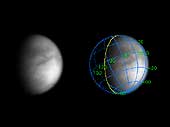 Through the Haze
Through the Haze
The Cassini spacecraft has beamed back a new, more detailed image of
smog-enshrouded Titan. This view represents an improvement in resolution
of nearly three times over the previous Cassini image release of Titan
(see PIA05392).
The superimposed coordinate system grid in the accompanying image at right illustrates the geographical regions of the moon that are illuminated and visible, as well as the orientation of Titan. North is up and rotated 25 degrees to the left. The yellow curve marks the position of the boundary between day and night on Titan. This image shows about one quarter of Titan's surface, from 0 to 70 degrees West longitude, and just barely overlaps part of the surface shown in the previous Titan image release. Most of the visible surface in this image has not yet been shown in any Cassini image.
The image was obtained with the narrow angle camera on June 14, 2004, at a phase, or Sun-Titan-spacecraft, angle of 61 degrees and at a distance of 10.4 million kilometers (6.5 million miles) from Titan. The image scale is 62 kilometers (39 miles) per pixel. The image was magnified by a factor of two using a linear interpolation scheme. No further processing to remove the effects of the overlying atmosphere has been performed.
The observed brightness variations are real, on scales of one hundred
kilometers or less. The image was obtained in the near-infrared (centered
at 938 nanometers) through a polarizing filter. The combination was
designed to reduce the obscuration by atmospheric haze. The haze is more
transparent at 938 nanometers than at shorter wavelengths, and light of
938 nanometers wavelength is not absorbed by methane gas in Titan's
atmosphere. Light at this wavelength consequently samples the surface,
and the polarizer blocks out light scattered mainly by the haze. This is
similar to the way a polarizer, put on the front of a lens of a hand-held
camera, makes distant objects more clear on Earth.
(Courtesy NASA/JPL/Space Science Institute)
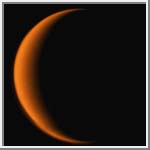 Crescent View of Titan
Crescent View of Titan
The Voyager 1 spacecraft took this crescent view of Titan on
November 13, 1980. The opaque orange colored haze, believed to be
composed of photochemically produced hydrocarbons, prevented
the spacecraft from seeing Titan's surface.
(Copyright Calvin J. Hamilton)
 Pioneer 11 Image of Titan
Pioneer 11 Image of Titan
This image of Titan was taken by the Pioneer 11 spacecraft on September 3,
1979 from a range of 3.6 million km. It was constructed from the
red and blue channel data of image G-14. The quality
is limited due the limited quality of the Pioneer imaging
system as well as poor telecomunications at the time of the Titan
encounter. This is the first image of Titan to clearly show one
hemisphere brighter than the other.
(Courtesy NASA)
Burnham, Robert, "Hubble Maps Titan's Hidden Landscape," Astronomy, 44-45, February 1995.

 Saturn
Saturn Rhea
Rhea Hyperion
Hyperion